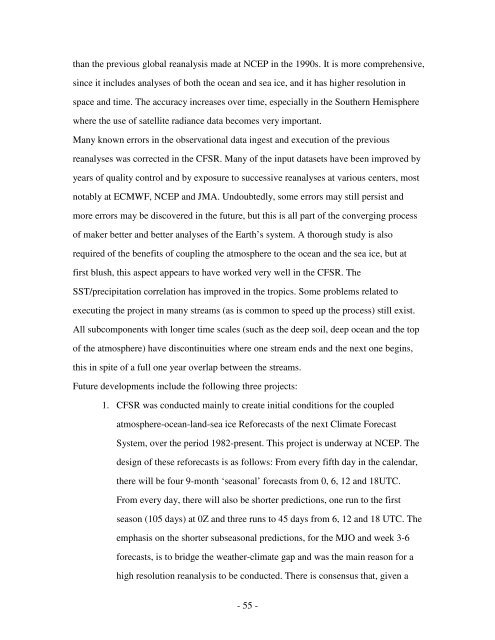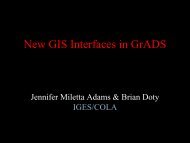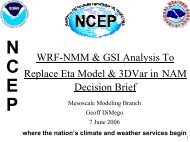The NCEP Climate Forecast System Reanalysis - NOAA National ...
The NCEP Climate Forecast System Reanalysis - NOAA National ...
The NCEP Climate Forecast System Reanalysis - NOAA National ...
You also want an ePaper? Increase the reach of your titles
YUMPU automatically turns print PDFs into web optimized ePapers that Google loves.
than the previous global reanalysis made at <strong>NCEP</strong> in the 1990s. It is more comprehensive,since it includes analyses of both the ocean and sea ice, and it has higher resolution inspace and time. <strong>The</strong> accuracy increases over time, especially in the Southern Hemispherewhere the use of satellite radiance data becomes very important.Many known errors in the observational data ingest and execution of the previousreanalyses was corrected in the CFSR. Many of the input datasets have been improved byyears of quality control and by exposure to successive reanalyses at various centers, mostnotably at ECMWF, <strong>NCEP</strong> and JMA. Undoubtedly, some errors may still persist andmore errors may be discovered in the future, but this is all part of the converging processof maker better and better analyses of the Earth’s system. A thorough study is alsorequired of the benefits of coupling the atmosphere to the ocean and the sea ice, but atfirst blush, this aspect appears to have worked very well in the CFSR. <strong>The</strong>SST/precipitation correlation has improved in the tropics. Some problems related toexecuting the project in many streams (as is common to speed up the process) still exist.All subcomponents with longer time scales (such as the deep soil, deep ocean and the topof the atmosphere) have discontinuities where one stream ends and the next one begins,this in spite of a full one year overlap between the streams.Future developments include the following three projects:1. CFSR was conducted mainly to create initial conditions for the coupledatmosphere-ocean-land-sea ice Reforecasts of the next <strong>Climate</strong> <strong>Forecast</strong><strong>System</strong>, over the period 1982-present. This project is underway at <strong>NCEP</strong>. <strong>The</strong>design of these reforecasts is as follows: From every fifth day in the calendar,there will be four 9-month ‘seasonal’ forecasts from 0, 6, 12 and 18UTC.From every day, there will also be shorter predictions, one run to the firstseason (105 days) at 0Z and three runs to 45 days from 6, 12 and 18 UTC. <strong>The</strong>emphasis on the shorter subseasonal predictions, for the MJO and week 3-6forecasts, is to bridge the weather-climate gap and was the main reason for ahigh resolution reanalysis to be conducted. <strong>The</strong>re is consensus that, given a- 55 -





